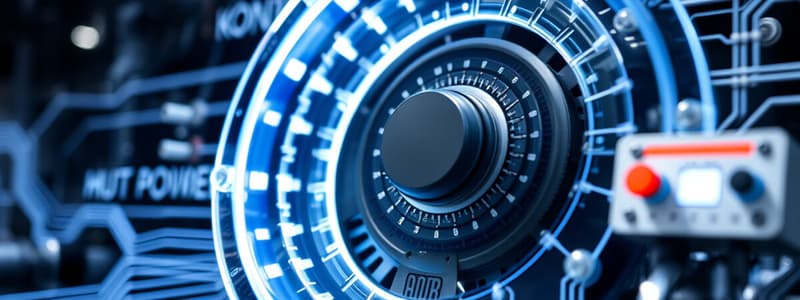Podcast
Questions and Answers
What characterizes a dynamic system with memory?
What characterizes a dynamic system with memory?
It is a system where the output depends on both past and current inputs.
Define a continuous-time system and provide an example.
Define a continuous-time system and provide an example.
A continuous-time system has signals defined for every moment in time, like analog electronic circuits.
What distinguishes discrete-time systems from continuous-time systems?
What distinguishes discrete-time systems from continuous-time systems?
Discrete-time systems have signals defined only at specific time intervals.
Explain the difference between deterministic and stochastic systems.
Explain the difference between deterministic and stochastic systems.
Give an example of an electrical system and explain its significance.
Give an example of an electrical system and explain its significance.
What is a SISO system, and where could it be typically employed?
What is a SISO system, and where could it be typically employed?
What are hydraulic systems used for? Provide a specific application.
What are hydraulic systems used for? Provide a specific application.
Define a manual control system and provide an example.
Define a manual control system and provide an example.
What is the primary characteristic of a MIMO system?
What is the primary characteristic of a MIMO system?
Describe what thermal systems are and provide an example.
Describe what thermal systems are and provide an example.
Flashcards are hidden until you start studying
Study Notes
What is a Control System?
- A control system manages, commands, directs, or regulates the behavior of other devices or systems through control loops.
- Found in applications ranging from household appliances to industrial machinery.
Types of Control Systems
-
Open-Loop Control System:
- Control action is independent of output.
- Example: Washing machine operates for a fixed duration.
-
Closed-Loop Control System (Feedback Control System):
- Control action is dependent on output.
- Example: Thermostat adjusts heating based on detected temperature.
Basic Components of a Control System
- Controller: Determines necessary actions for desired output.
- Actuator: Mechanism that implements the control action.
- Sensor: Measures output or system performance metrics.
- Feedback: Compares measured output to desired output for adjustments.
Control System Objectives
- Stability: Ability to return to desired state following disturbances.
- Accuracy: Degree of output matching desired output.
- Response Time: Speed of response to input changes or disturbances.
Control System Examples
- Automotive Cruise Control: Maintains vehicle speed through throttle adjustments.
- Aircraft Autopilot: Keeps aircraft on set course using control surfaces.
- Industrial Robotics: Executes precise tasks via sensors and actuators in production lines.
Mathematical Modeling
-
Transfer Function: Represents input-output relationship in Laplace domain.
- G(s)=Y(s)/U(s) - denotes system behavior.
-
State-Space Representation: Uses first-order differential equations to define systems.
- Formulation: ẋ=Ax+Bu; y=Cx+Du.
Control Strategies
- Proportional (P) Control: Adjusts control actions based on error magnitude.
- Integral (I) Control: Reacts to accumulated error over time.
- Derivative (D) Control: Responds to the error rate of change.
- PID Control: Integrates P, I, and D for a comprehensive control strategy.
System Analysis
- Stability Analysis: Evaluates system stability under various conditions.
- Frequency Response: Investigates system response to different input frequencies.
- Root Locus: Visual method to observe changes in system roots with varying parameters.
Practical Considerations
- Noise and Disturbances: Real-world systems must handle unpredictable factors in control strategies.
- Nonlinearities: Nonlinear behavior complicates control design and implementation.
- Implementation: Digital controllers need consideration of sampling and quantization effects.
Conclusion
- Control systems play a crucial role in modern engineering, automating regulation of complex systems.
- Comprehending fundamentals is essential for designing effective control systems in diverse settings.
Classification of Systems in Control Engineering
-
Based on Control Action:
- Open-Loop Systems operate independently of output conditions.
- Closed-Loop Systems adjust based on output feedback.
-
Based on Time Variability:
- Time-Invariant Systems have consistent parameters.
- Time-Variant Systems exhibit parameter changes over time.
-
Based on Linearity:
- Linear Systems apply the principle of superposition.
- Nonlinear Systems show output that isn't directly proportional to input.
-
Based on Behavior:
- Stable Systems return to equilibrium after disturbances.
- Unstable Systems diverge from equilibrium.
-
Based on Dynamics:
- Static Systems depend solely on current inputs.
- Dynamic Systems rely on both past and current inputs.
-
Based on Nature of Signal:
- Continuous-Time Systems operate on signals defined at all times.
- Discrete-Time Systems function on signals at specific intervals.
-
Based on Output Characteristics:
- Deterministic Systems produce predictable outputs.
- Stochastic Systems yield outcomes influenced by probabilistic elements.
-
Based on Energy Source:
- Electrical Systems operate using electrical energy.
- Mechanical Systems involve mechanical components.
- Hydraulic Systems use fluid pressure.
- Thermal Systems manage heat energy.
-
Based on Complexity:
- Single-Input Single-Output (SISO) Systems have one input and one output.
- Multiple-Input Multiple-Output (MIMO) Systems involve several inputs and outputs.
-
Based on Control Strategy:
- Manual Control Systems are operated by human intervention.
Studying That Suits You
Use AI to generate personalized quizzes and flashcards to suit your learning preferences.




